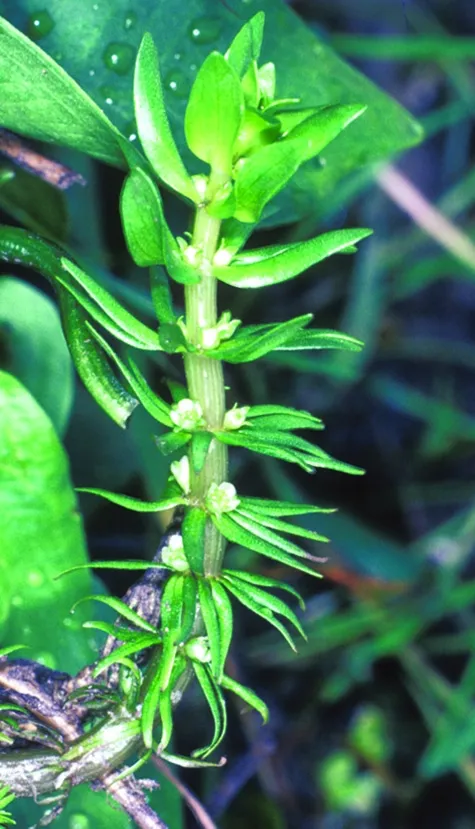Whorled Waterwort
Elatine alsinastrum






Elatine alsinastrum is a tiny, delicate annual herb, climbing or prostrate, whose height is 2-4 cm. It grows in vernal pools or at the edges of streams. It begins growing in the water and later in the season, the stems emerge and eventually dry up. The stems are hollow, cylindrical and do not branch. The submerged leaves are thin, linear and grow in whorls with many leaves (10-18) in each whorl. The leaves that protrude from the water are wider, lanced or oval, 2-3 per whorl. The flowers are tiny, located mostly in the stem node axils. The flower is composed of four greenish sepals and four whitish petals that are longer than the calyx. The number of stamens in the flower alternates (3-8) and the number of styles is four. The fruit is a tiny capsule with four cells; the seeds are numerous, tiny and dust-like. The seed is straight or almost straight. E. alsinastrum blooms in May-June.
The plant was discovered in Israel in the Golan in 1988 and is known today from only one location – En Dalve near El-Rom in the northern Golan.
Humid muddy depressions at the edges of springs and in locations where
water flows slowly on basalt soil at an altitude of 900 m. Most of the area
dries up toward June-July.
The genus Elatine includes ten species of delicate, miniscule herbs
immersed in shallow water, and they are distributed over many regions in the
temperate and tropical part of the globe. The genus distribution center is in
northern Europe, where eight species grow. Several species are cultivated for growing
in aquariums. The characteristic habitat of all of the species is seasonal
puddles or shallow water bodies. Survival in this type of habitat requires a
strategy of accelerated growth, because the habitat dries up rapidly. In
addition, the habitat is very fragmented, and effective means of distribution
and random spreading of the seeds using “dust seeds” is required. This is
demonstrated in Israel by a second species – Elatine macropoda, which
grows in puddles on rocky limestone on the central mountain range in Faqu'a, on
the Gilbo'a and farther away, near Mitspe Masu'a in the Philistean Plain. This species differs
from Elatine alsinastrum in its curved seed. It is found in six regions,
in over forty locations. It has cylindrical; opposite leaves and is similar in
its general shape to Silene sedoides. Elatine alsinastrum is fairly
common in puddles in the Golan and constitutes a major element in the aquatic plant
community named for it.
·
Damage to water bodies where the species grows are
the primary threat to its existence.
·
Known in Israel from a single location.
·
Its global distribution is extensive, its dispersal
itself is excellent, and it is not endangered on a global scale.
·
Not protected in nature reserves.
To try to locate additional populations in the northern Golan and in
additional water bodies, and to preserve them there. Attempts should be made to
populate it in additional water bodies in the Golan, e.g. the Sindiana Pond,
Peham Springs or Mesil Asnia. Cattle and sheep should be kept away from the
puddles, and the water should be kept clear.
The plant has a widespread disjunct distribution across large areas in
the temperate parts of Asia and Europe including the northern part of the
Mediterranean Sea basin.
Cytisopsis
pseudocytisus is a small, annual herb, partially immersed in
water, growing in seasonal puddles and the edges of water bodies. Has been
found to date in only one location in the northern Golan, which is a
northern-peripheral location that is not a nature reserve. It is the southernmost
location in the range of E. alsinastrum, with marginal climatic
conditions. This may be the reason that the plant has been found in only one
location so far, although its small size may make it difficult to sight, and
additional locations may be found in the central and northern Golan if the
appropriate moist habitats are preserved. These habitats are gradually being
destroyed, either illegally by the local population, or by the government, in
order to collect water and build reservoirs.
היימן, ר.1981. הצומח של מקווי המים בגולן. עבודת גמר, המחלקה לבוטניקה, האוניברסיטה העברית, ירושלים.
Current Occupancy Map
| 1000 squre meter pixel | 5000 squre meter pixel | 10000 squre meter pixel | |
|---|---|---|---|
| number of observations | 0 | 0 | 0 |
| in total pixels | 0 | 0 | 0 |
| Family | Elatinaceae |
| Classification | On the endangered species list |
| Ecosystem | Mediterranean humid |
| Chorotype | Euro-Siberian |
| Conservation Site | Ein Dalwve (near El Rom in Northern Golan |
| Rarity |
1
6
6
|
|---|---|
| Vulnerability |
0
3
4
|
| Attractiveness |
0
0
4
|
| Endemism |
0
0
4
|
| Red number |
1
5.3
10
|
| Peripherality | N |
| IUCN category | DD EW EX LC CR EN VU NT |
| Threat Definition according to the red book | Critically endangered |
 Based on:
Based on:






